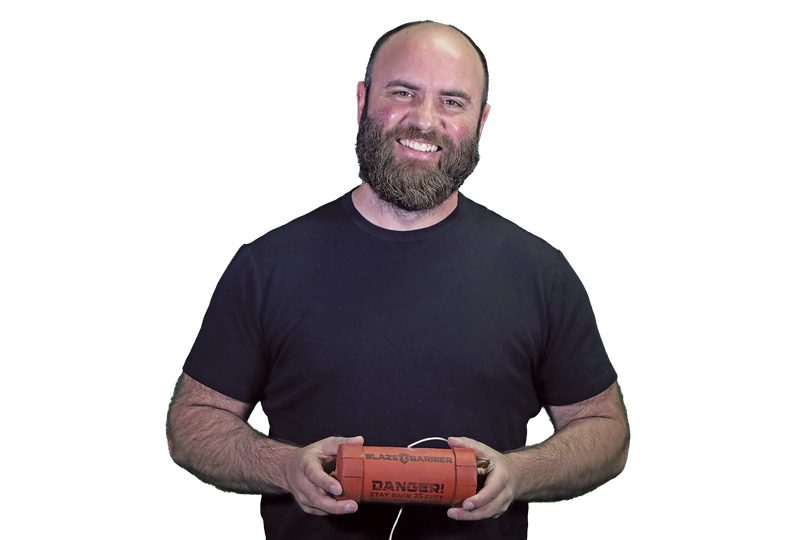Blaze Barrier looks to catch fire in INW
Growing threat of wildfires sparked the idea of an alternative suppressant system

Jacob Schuler, founder and CEO at Blaze Barrier Inc., says the company is accepting preorders for a new eco-friendly fire defense tool through a Kickstarter campaign.
| Erica BullockA Deer Park native has invented a fire extinguishing product, dubbed the Blaze Barrier, that aims to be a sustainable alternative tool in the defense against wildfires.
Jacob Schuler, founder and CEO of Spokane-based Blaze Barrier Inc., says he's preparing for production to begin next spring.
Designed for use by property owners and firefighting agencies, the Blaze Barrier is a set of portable and biodegradable fire retardant modules. Connected in either 50-foot or 100-foot lengths, the modules are meant to be similar in function to a fire line, which is a swath of land that has been cleared of combustible material to slow or stop the progression of a wildfire. Firefighters often must create fire lines with hand tools, and fast-moving winds sometimes defeat their efforts by whipping embers over the cleared area.
With the Blaze Barrier units, each individual fire extinguishing module deploys upon contact with a flame. A suppressing powder erupts five feet in the direction of the fire and five feet opposite the flames when it makes contact. The result is a 10-foot radius of smothered flames blanketed in an extinguishing agent that doubles as a soil fertilizer.
The protected area covers more ground than the U.S. Forest Service's standard fire line recommendation of 18 inches, he adds.
Property owners are meant to deploy the Blaze Barrier once they are alerted to wildfires in their area. Schuler notes that the product shouldn't be deployed too early since it becomes ineffective once it gets wet. Blaze Barrier is a single-use suppression system, although if the unit doesn't get activated, it can be repackaged and stored for future use.
Sustainability is a priority for Schuler, who says he was thinking of consumers who might need miles of the product to help fight fires.
"It's really important that the stuff we use ... is biodegradable, nonharmful, environmentally friendly, and can't get into water sources to affect food chains," Schuler says, adding that if activated, users won't have to go back out and pick up any product waste later.
Black powder and the biodegradable extinguishing agent are enclosed within each fire suppressant module, which are red tubes that resemble the shape of an oversized firecracker. The modules have a straw-based paper and cardboard exterior shell that is held together with dextrin-based glues, explains Schuler.
Modules are spaced evenly on either 50-foot or 100-foot lengths of twine string. Retail pricing of the 50-foot set is $395, and the 100-foot set is priced at $795.
 Photo provided by Blaze Barrier
Photo provided by Blaze Barrier Jacob Schuler's 12-year-old daughter illustrates how to deploy the Blaze Barrier during a product demonstration this summer.
Schuler is the only employee at Blaze Barrier. He left a full-time position as a product developer at Spokane-based Johnston Engineering PLLC last month to dedicate his time to the product launch.
For now, the company works with independent contractors in the development process, he says.
Blaze Barrier closed a pre-seed funding round that generated $300,000 with Avista Development, a subsidiary of Spokane-based Avista Corp., as the lead investor.
"The pre-seed funding (was needed) to take the next steps to set up manufacturing suppliers, machinery, facilities, and all of the stuff we need to roll this off the line," Schuler says.
A Kickstarter campaign was launched in August to secure additional funding to help with production and to generate revenue. Through the campaign, customers and other entities will have the option to prepurchase boxes of Blaze Barrier at discounted prices.
The Kickstarter campaign is accessible via the company's website, blaze-barrier.com. In the fourth quarter, after the campaign ends, products will be available for sale on the company's website and through other retail channels such as Amazon.com in early 2025.
"In addition, we'll be selling direct and through distribution partners to firefighters and firefighting government agencies," he says.
Schuler started the company as a home-based business and has relocated a few times to different commercial facilities. He currently is in the market for a new location suitable for manufacturing and distribution.
Manufacturing of the product will be automated through an assembly line process.
"We're trying to manufacture around here, so we can keep better control of quality and the output of safety that's involved in production," he explains.
The idea for Blaze Barrier was sparked when a wildfire threatened Schuler's hometown in 2021 and prompted three years of research and development, including about 100 different versions of the product, before he landed on the right combination of materials that could extinguish flames as he intended.
"Wildfires are a massive problem that affect people all the time," Schuler says.
The 2021 Ford Corkscrew Fire burned over 15,000 acres and threatened his community, which is located about 20 miles northwest of the city of Spokane.
A couple of Schuler's firefighter friends shared their experience working to contain the fire, and the challenges they faced, which prompted his research into finding alternative wildfire defense systems.
"It was a shock to me," he says. "I assumed ... that modern firefighters had modern equipment, but they're using hand tools."
While effective, the use of hand tools to create a fire line takes considerable time and energy in a dangerous situation, Schuler asserts.
Chip Overstreet, board member and adviser at Blaze Barrier, says in a press release about the latest funding campaign that the product is an ideal option for over 6 million homeowners who no longer have insurance coverage from wildfires.
"The Blaze Barrier cannot stop every wildfire, but any time a hand-dug fire line can be used as a defensive measure, the Blaze Barrier can be an effective alternative that can be deployed in a fraction of the time," says Overstreet.
Schuler concurs and says that the Blaze Barrier isn't going to replace any firefighting methods that are currently in use. He maintains that the product is intended to complement wildfire defense options for homeowners and firefighting agencies.
"There's a time and a place for fire," says Schuler. "If we can stop fires when they're small, we can keep them from becoming community-engulfing firestorms. If we had better control ... we can use fire to benefit the landscape."





